Pioneer Era
Click below for a downloadable copy of this article.
EARLY PIONEERS
The period following the Civil War was called Reconstruction (1865-1877). Florida had not experienced as much destruction as other southern states had, so rebuilding Florida mainly meant improving its government and economy.
People from the North began visiting Florida because they were drawn by the widely available land and warm climate, which was not only comfortable, but good for growing crops year-round. To create more farmland, people began draining the swamps. In 1881 Hamilton Disston purchased four million acres of land from the state, from Orlando to south of Lake Okeechobee. He paid one million dollars, or twenty-five cents per acre.
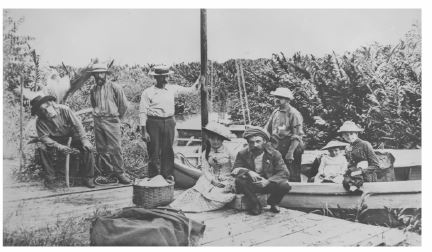
The Disston purchase included the northern edge of the Everglades. When he had the area drained, fertile soil was exposed that was perfect for growing crops. People moved into the area, many established farms, and resulting settlements later grew into towns and cities. Florida’s efforts to rebuild its economy were successful, and it soon became a leader in agriculture. During Reconstruction, pioneers began moving into present-day Palm Beach County.
In the 1870s, several families from the Midwest established homesteads around Lake Worth. They found a green jungle with no paths, roads, or means of transportation. They could only walk from place to place. If they owned a boat, they could travel by water.
The typical house of most settlers was made from palmetto thatching and items found at the beach. Items salvaged from shipwrecks were plentiful and used in a variety of ways. Pioneers were mainly farmers, but also survived by what they created and by what they could grow, hunt, and fish.
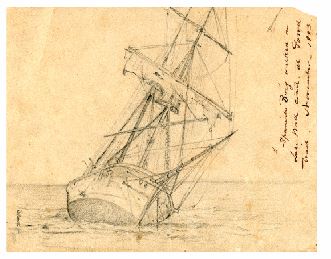
An important shipwreck occurred on January 9, 1878, when a small Spanish ship called Providencia ran aground in Palm Beach. The barque was carrying a cargo of wooden logs, animal hides, and 20,000 coconuts. Two settlers claimed the cargo and sold the coconuts to their fellow pioneers for two and one-half cents each. The settlers planted the coconuts in groves because they planned to develop them into a cash crop. It was from these coconut groves that the island, the county, and, eventually, several towns earned their names, including West Palm Beach and Palm Beach.
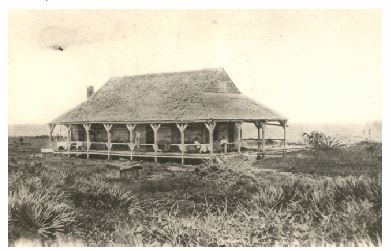
Numerous shipwrecks occurred along the east coast of Florida between Vero Beach and Miami that sometimes left sailors stranded with nowhere to go. The U.S. government built five houses of refuge along Florida’s east coast as temporary shelter for shipwreck survivors. The Orange Grove House of Refuge Number Three was built in 1876 on a beach north of present-day Atlantic Avenue in Delray Beach. It was destroyed by fire in 1927. The only refuge still standing today is the Gilbert’s Bar House of Refuge in Martin County, which is open to the public.

By 1886 the community around Lake Worth had grown so much that the residents demanded a school. The Dade County School District provided money, and the settlers donated the land and raised more money for lumber and school supplies. They also volunteered their time to build the first schoolhouse, which opened in March 1886. The first term was only three months long. Seven children attended school that first day, taught by sixteen-year-old Hattie Gale. This school building has been preserved and moved to Phipps Ocean Park on South Ocean Boulevard in Palm Beach. Most students know it as the Little Red Schoolhouse.
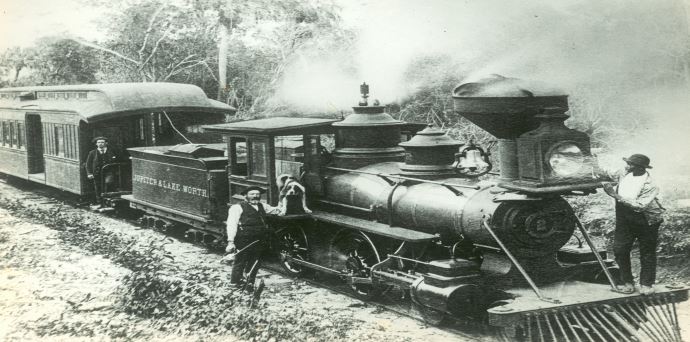
The Jupiter and Lake Worth Railroad (also known as the Celestial Railroad) was the area’s first railway. When it opened in 1889, it stretched from Jupiter to Juno (which was in a different location than today’s Juno Beach) and was seven and one-half miles long. There were two other stops called Mars and Venus, which were only to get wood to feed the wood-burning engine. The railway was built to transport produce and passengers. Passengers were charged ten cents a mile, or seventy-five cents one-way, for the thirty-minute journey. The train had no way to turn around, so it went forward from Jupiter to Juno (going south) and in reverse from Juno to Jupiter (going north). Legend has it that the engineer would stop the train when wild game animals were sighted. Passengers would get off the train, shoot the animal, and give a portion of their kill to the engineer. In 1895, the railway went out of business; the equipment was sold at auction a year later. The Celestial Railroad could not compete with Henry Flagler’s Florida East Coast Railway.
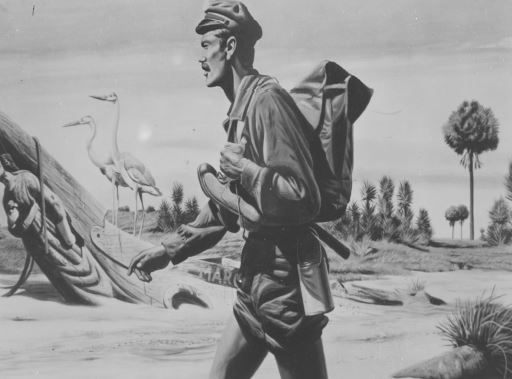

POSTAL SERVICE AND THE BAREFOOT MAILMEN
When early pioneers left their homes in the North, they continued to communicate with their families and friends back home. It was not easy to send a letter, though. They could not email or even drop a letter in a mailbox. At first, settlers depended on the honesty of passing ship crews to take and deliver their mail. They also asked beach walkers to carry and deliver mail on their way up and down the coast. These methods were not dependable. Sending a letter from Lake Worth to Miami took several weeks. First, it had to travel to Jacksonville. Then it was shipped to Cuba or Key West, and finally it went to Miami. Can you see why it took several weeks?
To solve this problem, the U.S. Postal Service set up a special route where several men took turns walking from Palm Beach to Miami and back. These mailmen later became known as barefoot mailmen, because they walked barefoot along the beach, carrying their shoes over their shoulders. The first barefoot mailman was Edwin Ruthven Bradley, who was paid $600 a year to make his weekly trips. These adventurous men traveled a route that was 136 miles round-trip and took three days each way. Each man walked an average of 7,000 miles a year. Most of the time, a mailman left Lake Worth on Monday and arrived in Miami on Wednesday. He began his return trip on Thursday and arrived home on Saturday. During his journey, the mail carrier spent two nights at houses of refuge in today’s Delray Beach and Fort Lauderdale. In Miami, he spent a night at a hotel. On Lake Worth, at Hillsboro Inlet, New River, and Biscayne Bay, the mailman had to cross water using boats left for his use.
There are many stories about the barefoot mailmen. They often charged a small fee to take passengers with them. One rumor involved a passenger who was upset over the long, hot walk, limited fresh water, and poor food. As revenge, he sent some coconuts through the mail. Then he sent a package of rocks. When he tried to mail a small tree, the mailman finally complained to the postal service in Washington, D.C. That resulted in a weight limit being placed on all deliveries.
Mailman Ed Hamilton lost his life while trying to complete his route. When Hamilton arrived at the Hillsboro Inlet on his way to Miami, he found someone had moved the mail boat to the far side of the inlet. To retrieve the boat, he apparently tried to swim across the inlet. Later, a search party found Ed’s mailbag hanging from a tree. His clothes were neatly folded and placed at the base of the tree but Hamilton was never found. No one knows whether Hamilton drowned or if sharks or alligators attacked him.
At least twenty brave men walked the beaches to deliver the mail from 1885 to 1893. When a road opened between Lantana and Miami, the barefoot mailmen were no longer needed; the mail traveled by stagecoach. By today’s standards, the barefoot-mailman system was primitive and dangerous, but it worked for the pioneers. Since then, automated services have been developed to help mail carriers package and send mail all over the world. They travel in automobiles and even in airplanes. The barefoot mailmen would be amazed at how efficiently mail is delivered in the twenty-first century.
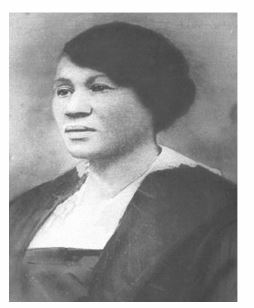
MILLIE GILDERSLEEVE
In 1876 Mildred “Millie” Gildersleeve became one of the first African American pioneers to settle in what is Palm Beach County. A former slave from Georgia, she married another African American pioneer, M. Jacob “Jake” Gildersleeve. Millie worked as a midwife and assisted Dr. Richard B. Potter, the first doctor on Lake Worth, to deliver most of the babies born in the area. Dr. Potter would pull up to Millie’s wharf and toot his whistle. Millie would run out the door with her medical bag, which contained everything she needed. Jake and Millie owned a vegetable farm in today’s Riviera Beach. Jake died in 1931, and Millie in 1950. Their daughter Katy was one of the first African Americans born in Palm Beach County. Millie and Jake raised five children in all, and their descendants still live here. James Henry Harper Jr. became a Florida state representative, and her great-great-great grandson Bradley G. Harper became a criminal judge.

DAVID LEVY YULEE
David Levy Yulee was born in St. Thomas, West Indies, to Jewish Portuguese parents. As a young boy, he and his family came to Virginia, and then Florida. Yulee studied and practiced law in St. Augustine. In 1838, while Florida was still a territory, he served as a delegate to the Florida Constitutional Convention, and was a representative to the U.S. Congress in the early 1840s. After Florida became a state, Yulee was elected to the U.S. Senate and served 1845-1851 and 1855-1861. He was the first man of Jewish descent to serve as U.S. senator. During the Civil War, he was a congressman for the Confederate States of America. Besides working with the government, Yulee owned a plantation and a sugar mill. He is also considered the Father of Florida’s Railroads because he completed Florida’s first cross-state railroad. That system connected Cedar Key on the west coast to Fernandina on the east coast. In 1880, Yulee moved to Washington, D.C., and six years later, he died in New York City.
MEXICO FRANK
The pioneers knew Frank Lopez as Mexico Frank. He arrived on Lake Worth in the summer of 1874, and for three years, did different jobs for the pioneers. During the winter of 1877 Frank boarded his small boat and sailed south. He never returned. He might be the first Hispanic known by name to live in what became Palm Beach County.
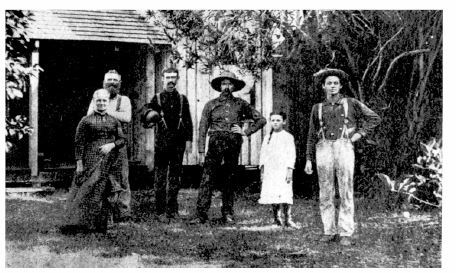
PIONEER-STYLE DINNER
In his memoir, Charlie Pierce wrote that his family spent the Christmas of 1873 at Charlie Moore’s place on Lake Worth. They ate a scrumptious dinner that included opossum with sweet potatoes covered with bacon strips, biscuits with cane syrup, and prickly pear pie for dessert. Seven years later, the small community shared Christmas dinner on the grounds of the Cocoanut Grove House Hotel. This meal included roast venison, turkey, bread, biscuits, salads, cakes, pies, and pudding.
PIONEER-STYLE SYRUP
In 1879, some pioneers decided to try to make syrup from sugar cane. They began by constructing a mill to do the processing. They created rollers from logs found on the beach. A mule provided the power to turn the rollers. The liquid from the cane was boiled in a huge iron kettle until it thickened into syrup. When the pioneers tasted their first batch of homemade sugar cane syrup, it was disgusting! It was salty, not sweet. The settlers realized that the soil where the sugar cane had grown had salt in it from the sea spray that the wind spread over the area. The pioneers’ attempt at making syrup came to an end.
PIONEER SOAP
When we run out of soap, we go to the store, but the early settlers on Lake Worth could not do that. The nearest store was in Titusville, about 160 miles to the north by boat. What did they do when they ran out of soap? They made their own. The pioneers collected hardwood ash from campfires and placed it in a barrel with a hole in the bottom. Then they added water to the barrel with the ash. When the water drained into a pail, the result was lye, which then went into an iron kettle. Last, the settlers added fat, usually from alligators, and boiled it over an open flame to create soap.

- Why did people come to Florida?
- Why was the Jupiter and Lake Worth Railroad also called the “Celestial Railroad”?
- Who was Hattie Gale?
- Describe the typical house of the settlers.
- What ship brought 20,000 coconuts?
- How did the coconuts change our area?
- How long was the Jupiter and Lake Worth Railroad? Why was it closed?
- What was the author’s purpose for writing about her?
- How did Millie contribute to the pioneer community?
- What cargo did Providencia spill when it wrecked on what is now Palm Beach?
Using a map, trace the route the barefoot mailmen had to walk from Lake Worth to Miami.
- Write a one-page essay about what it would be like to be a barefoot mailman.
- Write a one-page essay about what it would be like to be an early pioneer in Florida.
If you made $600 a year as a barefoot mailman, what was your monthly salary?

5 Responses
Would like a photo, if possible, of Ruth Dubois Nelms (Merchant) who was a member. She is my mother and recently deceased.
I am sorry for your loss. Please contact our director of research, Rose Guerrero, at rguerrero@pbchistory.org.
How did Charlie Pierce’s family cross from the gulf coast of Florida to the Atlantic coast by land or waterway. Is Fort Pierce, FL named after Charlie Pierce?
The Pierce Family first settled in Cedar Key, then sold the boat they took, moved to Titusville, then went to Jupiter. Fort Pierce was named after the Fort Pierce Army post built nearby in 1838 during the Second Seminole War. The military post had been named for Benjamin Kendrick Pierce.
What is the story of the fire that destroyed the Styx. Legend has it, blacks were invited to barbeque and were “burned out” while at the event. What is the valiidity of this account ?